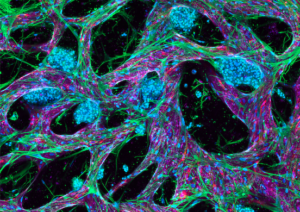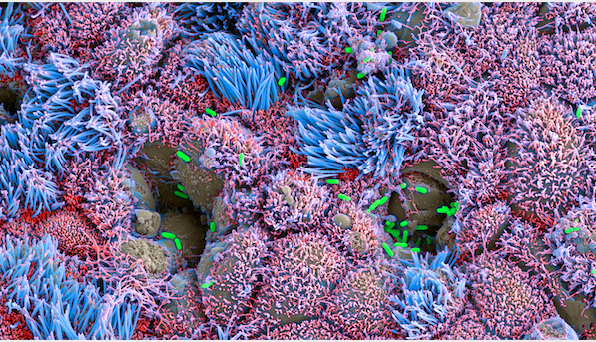By: Julianna LeMieux, PhD
Andrei Georgescu, PhD, CEO of Vivodyne, was hoping to couple his interests in science and engineering when he chose UPenn for his graduate research. His goal was to build on his background in microfluidics (from previous work including a Master?s degree at Cornell University working on integrating lab on chip applications at a large scale) to improve the ability to predict, validate, and test drugs. ?I feel like there is this little part of human nature that says, we should build tools,? Georgescu told GEN.
At UPenn, he met Dan Huh, PhD, associate professor in the department of bioengineering, whose lab focuses on the development of complex models of human tissues. Georgescu and Huh soon realized that they had complementary interests: Huh could develop complex tissues but wasn?t sure how to scale them. Georgescu knew how to scale, but not how to grow complex biology.
Georgescu was skeptical at first about the complex tissues. But, during his first days in Huh’s lab, he looked through the microscope, and thought, ?How is this possible? How are cells building this stuff without us?? He was ?immediately hooked,? and sought to develop ways to grow them into tens (or hundreds) of thousands of cells.
Huh and Georgescu ?hit it off? and shared a vision for how they could scale up the ability to gather human data before clinical trials. Given that, Georgescu not only earned his PhD in the Huh lab, but they also laid the foundation for the company that they co-founded?Vivodyne.

Today, Vivodyne?s discovery pipeline and AI-driven platform, which hopes to help develop drugs by testing directly on lab-grown human organ tissues, announced the close of $38 million total in seed financing, led by Khosla Ventures.
Huh and Georgescu’s first goal was to make realistic tissues. Their second goal was to scale them.
The Huh lab explored biochemical mechanisms to stimulate these tissues by combining different media with different cell types. They asked, how can we stimulate these cells to self-assemble into tissues from an initial emulsion? And then, how can they maintain a fusible vascular network while also maintaining the tissue-specific function?
In the two and a half years that the almost 50-person company has existed, the team has been able to develop a large library of different tissues in the human body and different functional parts of human organs. The tissues, they say, can mimic both spatial organization and function of human tissues.
This allows Vivodyne to use patient derived cancer tissue, for example, that is vascularized, and perfuse CAR-T-cell therapies to identify how those therapies can be optimized to kill the cancer. This is challenging with spheroids or organoids. With organoids, Georgescu said, you are modeling the development of the tissue, and not the function of the mature tissue itself.

Currently, the only type of data, Georgescu asserted, that can be collected at a sufficiently large scale to allow AI training, is that coming from cells growing on flat plastic. But those data are missing cell to cell interactions. In contrast, he notes that Vivodyne?s models allow the gathering of data that is complex, maps to humans, and can be gathered at a scale that is sufficiently high throughput for AI to learn from it.
At Vivodyne, they cultivate the tissues and introduce them into high throughput microfluidics?all of which are attended by an instrument called the Hive Pro. The fundamental technology lies in the integration of the science behind how they grow these tissues, the optimized approaches for growing this tissue specific vasculature that is perfusable, the support of the development of tissues around it, the engineering of the microfluidics, and how they package it in the scale of the automation used.
And it?s not just tissues. The group published work last year, in Nature Methods in the paper, ?Geometric engineering of organoid culture for enhanced organogenesis in a dish,” illustrating that vascularization of organoids is possible. In the paper, the authors noted that they, ?describe the extension of our approach to engineer vascularized, perfusable human enteroids, which can be used to model innate immune responses in IBD. This work provides an immediately deployable platform technology toward engineering more realistic organ-like structures in a dish.?
Vivodyne is not selling a platform. Rather, they will generate data in-house in collaboration from a drug discovery company. Currently, they work with pharma companies to create what they call clinically supporting data in cases where patient recruitment and clinical trials are challenging: in niche patient populations or patients with conditions that do not allow you to test on them.
Georgescu says that the company?s platform is part of the bridge between what is the promise of AI and what is the current state of AI for drug discovery. Right now, the entire body of data is from cells in 2D. And so it is not the AI itself that is limiting, or the models, or the compute power. It is the in input data currently. The data is not right, said Georgescu.
?By testing drugs and life-saving biologics directly on these realistic human tissues at an unprecedented scale and resolution, we can improve the success rates of therapeutics entering clinical trials,? said Alex Morgan, Partner at Khosla Ventures. ?Vivodyne?s technology bridges the gap between preclinical R&D and human clinical trials, while automating every step of the testing pipeline, from growing tissues, dosing, sampling and imaging, to analyzing data. The ability to screen and develop new potential lifesaving therapies, testing thousands at a time on functionally realistic human tissues on Vivodyne?s automated platform, is a major step forward for the pharmaceutical industry.?
n
